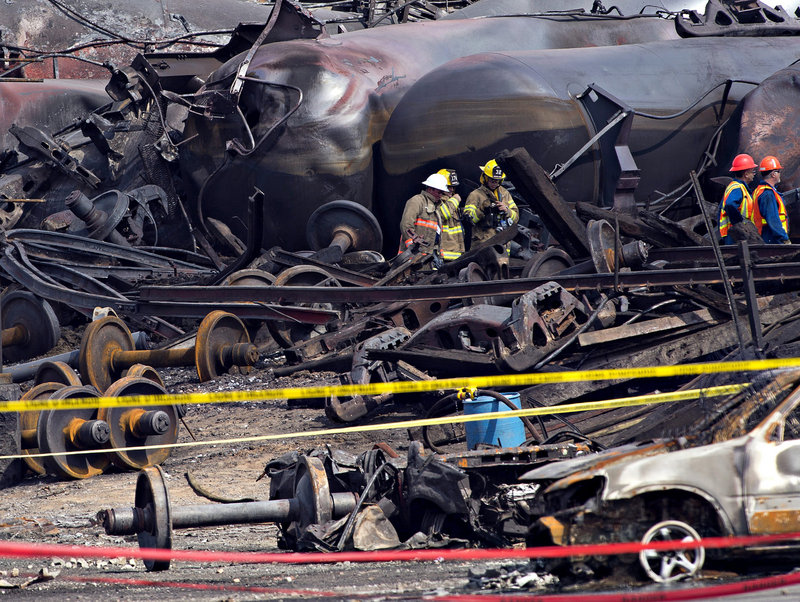A bill submitted by Maine’s U.S. Rep. Mike Michaud that would prohibit railroads from using one-man train crews will face a fight from the industry, which says it is an unnecessary measure aimed at protecting jobs rather than improving safety.
But unions that represent railroad workers are rallying behind the bill, saying it would help prevent the kind of accident that killed 47 people in Lac-Megantic, Quebec, last month.
Meanwhile, the Montreal, Maine & Atlantic Railway, the Maine-based railroad whose train derailed and exploded in Lac-Megantic on July 6, said it may resume running trains through the town this week, but it will no longer haul oil.
“That traffic is going to go other ways, not over our lines,” the railroad’s chairman, Ed Burkhardt, told the Montreal Gazette on Monday.
The train that derailed was hauling 72 cars loaded with crude oil on a route that would have crossed Maine to a refinery in Saint John, New Brunswick.
The accident occurred after the train was parked for the night on a main line uphill from the town. Unmanned, it rolled down the track, derailed and exploded in the town center.
Canadian investigators so far have determined that the train’s sole crew member failed to set enough hand brakes on the train’s cars.
After the accident, the Canadian government issued an emergency order banning one-person crews on trains carrying hazardous cargo, such as crude oil.
Michaud’s bill, which has not yet been printed, would require two-person crews on all freight trains running on rail lines. It would not apply to locomotives moving cars in rail yards.
One-man crews are used primarily by short-line railroads like the Montreal, Maine & Atlantic, which is based in Hermon. The railroad is the only freight railroad in Maine that uses one-man crews.
Burkhardt, a pioneer in the industry in the use of smaller crews, said Monday that one-man crews are safer because the engineer can concentrate on the job if no one else is in the cabin.
“Otherwise, you are carrying somebody around who is not being productive,” he said, and “may be a distracting influence.”
He said railroads in Europe, Australia and New Zealand use one-man crews for the most part.
New technology has made it easier for one person to drive a train, Burkhardt said. When an engineer has to throw a switch, he can leave the cab and move the train from alongside the tracks with sophisticated remote control technology that costs about $50,000 per train.
There is no research that proves one-man crews are unsafe, said Richard Timmons, president of the American Short Line and Regional Railroad Association, which represents about 500 railroads in the United States.
“There is no reason to adopt” Michaud’s measure, he said. “There is not science that supports it.”
The accident in Lac-Megantic was not caused by the use of a one-man crew, Timmons said. Rather, unions that for decades have fought for minimum-manning clauses in contracts are taking advantage of the “sensational” accident to advance their agenda to protect jobs.
But James Stem Jr., chief lobbyist for the International Association of Sheet Metal, Air, Rail and Transportation Workers, said the accident may have been prevented if the train had had two crew members.
It would take a single crew member two hours to properly park a 72-car train on a hill, he said. With two crew members, the task could be done in 25 to 35 minutes, in part because the engineer in the cab could release the air brakes on the locomotive after a conductor on the ground had set the hand brakes on the cars, to make sure they hold the train.
Also, Stem said, the two crew members would check on each other to make sure they both follow the rules.
If a manager refuses to pay overtime to finish a job properly, he said, two people are better able challenge the manger than one individual.
Stem blames the accident in Lac-Megantic on management decisions to save money. He said the Montreal, Maine & Atlantic was trying to reduce overtime costs and didn’t give the engineer enough time to secure the train.
“If the public had known the level of disregard for public safety, there would have been a revolt,” he said.
Several decades ago, trains were run by five-man crews, with some crew members riding in cabooses. Major railroads now use two-man crews.
In the deregulation of the industry in the 1980s, short lines that would have been abandoned because of the high cost of labor contracts were allowed by the federal government to operate without those contracts, said Sandra Dearden-McKay, a transportation consultant based Indiana.
She said the use of one-man crews has allowed the railroads to survive and continue to serve shippers.
Because the unions have used public safety as an argument to maintain crew sizes, they have lost some credibility, said Gary Chaison, a labor-law professor at Clark University in Worcester, Mass.
He said the unions might be successful if they can show that last month’s accident could have been prevented by a two-man crew, and that the cost of an additional worker is not too great a burden on railroads.
Tom Bell can be contacted at 791-6369 or at:
tbell@pressherald.com
Send questions/comments to the editors.



Comments are no longer available on this story